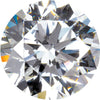Zircon versus Cubic Zirconia versus Zirconium
Posted by Joanna Rubini on
What is the difference between Zircon, Zirconia and Zirconium?
"Cubic Zirconia (CZ) is the cubic crystalline form of zirconium dioxide (ZrO2). The synthesized material is hard, optically flawless and usually colorless, but may be made in a variety of different colors." -Wikipedia. Zirconium oxide in nature is monolithic in its stable form under normal atmospheric conditions. CZs are  fabricated using zirconium oxide powder plus a stabilizer so that it forms cubic (isometric) crystals (same as diamonds). The stabilizer is required for cubic crystals to form and remain stable at ordinary temperatures. The use of different stabilizers in differing amounts influences the color of the crystals grown. Additionally, manufactures can add coatings which can further enhance the brilliance and durability of the CZs. But ultimately, CZ's are all relatively the same inherent material inside, some with more elaborate marketing.
fabricated using zirconium oxide powder plus a stabilizer so that it forms cubic (isometric) crystals (same as diamonds). The stabilizer is required for cubic crystals to form and remain stable at ordinary temperatures. The use of different stabilizers in differing amounts influences the color of the crystals grown. Additionally, manufactures can add coatings which can further enhance the brilliance and durability of the CZs. But ultimately, CZ's are all relatively the same inherent material inside, some with more elaborate marketing.
Zircon is the common name for zirconium silicate (ZrSiO4) . The word "zircon" itself comes from the Persian word "zargun" meaning golden color. It is a naturally occurring mineral highly present all over the earth. Chances are, if you've seen  sand, you've seen zircon. Because there are variations in the elements present in the mineral, it varies in colors -yellow, red or brown. The most common color, brown stones are often heated and or irradiated to change them to the bluish green
sand, you've seen zircon. Because there are variations in the elements present in the mineral, it varies in colors -yellow, red or brown. The most common color, brown stones are often heated and or irradiated to change them to the bluish green 
Zirconium is a very strong, malleable, ductile, lustrous silver-gray metal. Its chemical and physical properties are similar to those of titanium. It behaves similarly to titanium, has a hardness like copper, and is extremely heat and corrosion resistant. It is obtained from the mineral zircon (the stone previously  described) (ZrSiO4) and baddeleyite (ZrO2) through a process known as the Kroll Process (sorry folks...too much science to stuff in here!) It is found in jewelry in both it's natural color and blackened form. The blackened form is oxidation obtained by heating it for several hours, after which the metal reacts with the air to form a hard, black, coating of zirconium oxide- which is permanent and durable. Although sources say that it is not resizable, since we can resize titanium here at Rubini Jewelers, and zirconium behaves in kind, my guess is that it is resizable at least within a size up or down.
described) (ZrSiO4) and baddeleyite (ZrO2) through a process known as the Kroll Process (sorry folks...too much science to stuff in here!) It is found in jewelry in both it's natural color and blackened form. The blackened form is oxidation obtained by heating it for several hours, after which the metal reacts with the air to form a hard, black, coating of zirconium oxide- which is permanent and durable. Although sources say that it is not resizable, since we can resize titanium here at Rubini Jewelers, and zirconium behaves in kind, my guess is that it is resizable at least within a size up or down.
IN SUMMARY: Cubic Zirconia= Synthetic Material that looks like diamond. Zircon=Natural Mineral that can be cut into gemstones and used in jewelry applications. Zirconium=Natural metal (although it needs to be refined for purity) used in many applications (especially corrosive environments) including jewelry applications.
